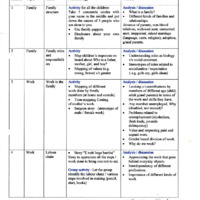SCHOOL HEALTH PROGRAMME MODULE
Item
- Title
- SCHOOL HEALTH PROGRAMME MODULE
- extracted text
-
SDA-RF-CH-4A.9
J
MODULE
Session
Topic
Issues
Methodology
Content
1
Family
Family
structure
Activity for all the children:
Take 5 concentric circles with
your name in the middle and put
down the names of 5 people who
are close to you.
• Use family puppets
• Disclosure about your own
family
Analysis / discussion
• What is a family?
• Different kinds of families and
relationships.
Absence of parents, non-blood
relatives, widowed aunt, unmarried
aunt, stepparent, mixed marriage
(language, caste, religion), adoption,
grand parents.
2
Family
Family roles
and
responsibilit
ies
Activity
• Map children’s responses on
board about Who is a father,
mother, girl, and boy?
• Mapping of values (e.g.
strong, brave) v/s gender
Analysis / discussion
• Understanding roles as biology
v/s social construct.
• Stereotypes of roles related to
socialization / expectation
(e.g. girls cry, girls clean)
3
Work
Work in the
family
Activity
• Mapping of different
work done by family
members (at home and outside).
• Time mapping Costing
of mother’s work.
• Surgeon story (stereotype of
male / female work)
Analysis / discussion
• Looking a t contributions by
members of different age (child,
adult grand parents) in terms of
the work and skills they have.
• Any member unemployed. Why
(disabled, not trained)?
• Problems related to
unemployment (alcoholism,
flesh trade, juvenile
delinquency)
• Value and respecting paid and
unpaid work.
• Gender based division of work.
• Why do we work?
4
Work
Labour
chain
• Story “E rotti hege banthu”
Story to appreciate all the steps /
work done to bring one roti to eat.
Analysis / discussion
• Appreciating the work that goes
behind everyday objects.
• Interdependency of different
professions.
• Importance of different kinds of
work.
Group activity : Let the group
identify the labour chain / various
steps involved in making (pencil,
shirt, books)
e
HO
a/6
5
Work
Different
professions
• Ice breaker - High - low
( superior / inferior) exercise with
children to understand how they
perceive different professions
(e.g. conductor, beggar)
Activity
• Mapping common
professions
vis a- vis gender, caste, class &
ability
Listing various professions (like
police, fireman, pilot, military,
tailor, cook, beautician, carpenter,
printer, dyeing, STD booth
doctors, teacher, nurse, sweeper)
on the board and mapping them
vis -a- vis gender, caste, class and
ability.
Analysis / discussion
Attitude, our own and given to us
by the society.
•
Analyzing caste gender, ability
and class vis-a-vis professions.
Share that all individuals are
endowed with certain strengths
and weaknesses, which should
not make him/her superior or
inferior.
•
Understanding stereotypes in
profession based on gender,
caste, class.
•
Dignity of labour
Education is a tool to transcend
the barriers.
6.
Role
models
Interactive session with role
models who have braved the
barriers of cast, ability and gender
• Women auto driver Shanthi
• Saraswathi Caste.
• Man with disability(venki)
• Women on the wheel chair.
• Inputs on ability by APD
HW: Write down your dream
profession.
7.
Education
Module on Education.
Introduction: What is your dream job? Map on board
Pick up 4 profession (could be. Doctor, Teacher, Cook, Tailor), What do
you need to become that? — Group activity/ presentation.
Skills (natural and acquired) ---- Analysis and discussion
• you learn skills at home. School, Community (friends, neighbors)
• What do you learn from home ( attitudes, superstition, religion,
habits)
• What do you learn at school (3 Rs, and social skills)
• Vocational courses (carpentry, plumbing)
• What is the role of school in highly skilled jobs like cooking,
carpentry etc. (to speak in a larger group, with different people,
exposure to different experience, things that they learn that are
outside the textbook.
8.
Health &
Hygiene
9.
Nutrition
10*
II.
Puppet show
Inequality in food distribution.
Balance diet
life. C*|cle
Gender /
discrimina
tion
Family
(can we
have
Shekar?)
Peace /
ethnic
violence
Meena film
Conflicts in
the family
Ice-breaker:
Warm-up exercise of speaking in
different tone / pitch.
Activity
Role-play / playback theatre of a
fight.
Analysis / discussion
Self: Conflict with in one self
(related to decision making
e.g. getting signature on
report card, if failed)
• Family: Sibling rivalry,
conflict with friends.
• Why do conflicts arise?
• Empathy, recognizing good
and bad traits in every
person.
• Good communication
(listening, speaking tone)
• Community: conflict with
neighbors.
• Understanding tools to
resolve conflict.
10
Life cycle
Introduction: Body mapping (could be a group activity)
Children are instructed to ask one of their classmates to lye down, a out
line of his/her body is draw. They are then instructed to put down parts
of the body that are visible. Then they are asked to put down body parts
that are not visible.
Analysis / discussion: Use abacus chart
13. Different stages of life
14. Their will be changes both physical and emotional
15. What are those changes?
16. Why do they happen?
17. It happens to every one
18. It is normal.
Question box: an interactive session. Children are given 10 minutes to
put down the questions they have on apiece of paper. The facilitator will
answer them.
- Media
 SDA-RF-CH-4A.9.pdf
SDA-RF-CH-4A.9.pdf
Position: 6174 (1 views)
